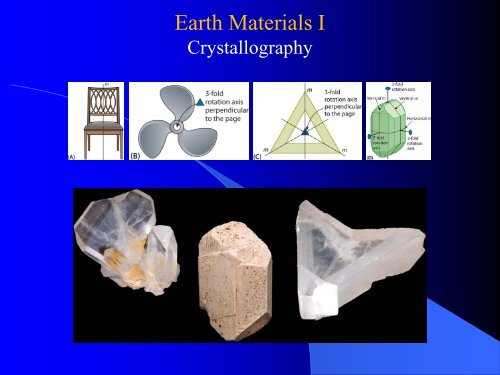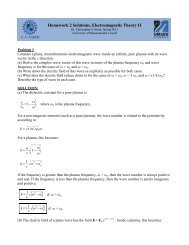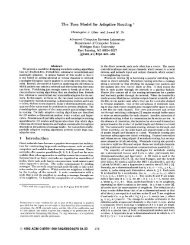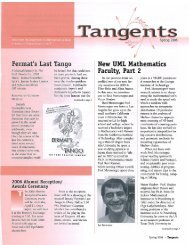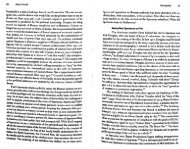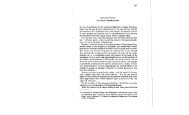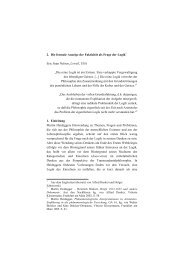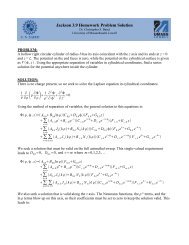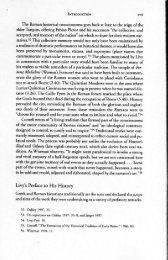Lecture - Introduction to Crystallography - Faculty Server Contact
Lecture - Introduction to Crystallography - Faculty Server Contact
Lecture - Introduction to Crystallography - Faculty Server Contact
You also want an ePaper? Increase the reach of your titles
YUMPU automatically turns print PDFs into web optimized ePapers that Google loves.
Earth Materials I<br />
<strong>Crystallography</strong>
Symmetry – repetition of objects<br />
(a<strong>to</strong>ms, ions, ionic groups)<br />
through reflection, rotation,<br />
inversion, and translation<br />
<strong>Crystallography</strong> – study of the<br />
external form and the crystal<br />
structure of crystalline solids and<br />
the principles that govern their<br />
growth, shape, and internal a<strong>to</strong>mic<br />
arrangement.
Symmetry Element – geometric feature that expresses the<br />
symmetry of an ordered arrangement.<br />
Element<br />
Mirror Plane (m)<br />
Rotation axis<br />
Center of symmetry (i)<br />
Ro<strong>to</strong>inversion axis<br />
Operation<br />
Reflection through a plane<br />
Rotation about an axis by some fraction<br />
360 o /n, where n = 1, 2, 3, 4, or 6.<br />
Inversion through a point<br />
Rotation with inversion<br />
Mirror – reflect an object, or a<br />
specific crystal face, or a unit<br />
of structure in<strong>to</strong> its mirror<br />
image.
Rotation axis – an imaginary line<br />
about which an object, or a crystal<br />
face, or an a<strong>to</strong>mic arrangement is<br />
rotated and repeats itself.<br />
Illustration of mirror planes and rotation<br />
axes for a crystalline form.
Center of symmetry<br />
Inversion<br />
Ro<strong>to</strong>inversion
Hermann-Mauguin notation explained
Miller Indices<br />
Three integers identifying a type of crystal plane; the intercepts of a plane on the three<br />
crystallographic axes are expressed as fractions of the crystal parameters; the reciprocals of these<br />
fractions, reduced <strong>to</strong> integral proportions, are the Miller indices. Also known as crystal indices.
Miller Indices for various planes in a cube.<br />
For further information about Miller Indices and<br />
a nice animation go <strong>to</strong><br />
http://chemistry.bd.psu.edu/jircitano/Miller.html
Miller-Bravais Index in the hexagonal system
Form – a group of like crystal faces, all of which have the same relation <strong>to</strong> the<br />
symmetry elements.<br />
A form includes the whole set of<br />
crystal faces. Using the illustration <strong>to</strong><br />
the right<br />
form {hkl} = {111}<br />
For a specific crystal face in the form:<br />
(111). Note the difference, it is<br />
important.<br />
In the case of a general form, designated {hkl}, the faces intersect the<br />
crystallographic axes at different lengths.
Open form – doesn’t enclose space<br />
Closed form – encloses space<br />
Types of Open forms<br />
• Pinacoids – two parallel<br />
faces {100}, {010}, {001}<br />
• Prisms – four parallel faces<br />
{110}, {101}, {011}<br />
Some examples of closed forms<br />
• Rhombic dipyramid {111} – eight inclined corner faces<br />
• Octahedron {111} – eight triangular faces<br />
• Dodecahedron {011} – 12 rhomb-shaped faces<br />
• Tetrahexahedron {0kl} – consists of 24 isosceles triangular faces
Zone – a collection of crystal<br />
faces with parallel edges.<br />
In crystal classes with<br />
orthogonal axes (isometric,<br />
tetragonal, orthorhombic)<br />
zone axes correspond with<br />
crystallographic axes. For<br />
example, zone [001] is<br />
perpendicular <strong>to</strong> face (001).<br />
In crystal classes where all<br />
axes are not orthogonal, the<br />
zone axes do not correspond<br />
<strong>to</strong> some or all of the<br />
crystallographic axes.
Twins – rational, symmetrical intergrowths of two or more crystals of the<br />
same substance.<br />
The two or more individuals are related by a new symmetry element that<br />
was not already present in the untwinned single crystal. Twin laws -<br />
• A mirror plane or twin plane<br />
• A rotation axis or twin axis<br />
• An inversion about a point or twin center<br />
Mirror plane<br />
Rotation axis
Primary twins (growth twins) are due <strong>to</strong> nucleation errors that occur during<br />
crystal growth. The original pattern of the crystal is interrupted in a regular<br />
way.<br />
Secondary twins – modification of a crystal after its formed. Result of<br />
mechanical deformation or displacive transformation of one polymorph in<strong>to</strong><br />
another.<br />
Twins are classified as<br />
• <strong>Contact</strong> twins – a regular composition plane joins the two individuals<br />
• Penetration twins – appear <strong>to</strong> be intergrown. Usually produced by<br />
rotation and defined by an axis of rotation.<br />
• Multiple twins – three of more individual crystals are twinned<br />
according <strong>to</strong> the same twin law. Polysynthetic twin if all the<br />
composition faces are parallel
Example:<br />
Spinel twin – twin plane is {111} which is not a mirror plane in the isometric<br />
point group 4/m 3 2/m.
Examples of <strong>Contact</strong> twins<br />
The mirror plane is perpendicular <strong>to</strong> b and therefore is (010)
Penetration twin – twining of monoclinic orthoclase 2/m<br />
2-fold rotation axis is parallel <strong>to</strong> b.
Development of a polysynthetic (albite)<br />
twin. Mirror reflection parallel <strong>to</strong> (010).<br />
This example is for a triclinic crystal and<br />
the only symmetry element is i.
In the case of the 32 point groups all the symmetry elements intersect at one<br />
point in the center of the crystal. There isn’t any translation.<br />
In the case of the space groups we add an additional symmetry element<br />
which is translation. This gives rise <strong>to</strong> the 230 space groups.<br />
These new elements are<br />
• Translation – this element leads <strong>to</strong> the 14 Bravais Lattices. These are<br />
three dimensional arrays of nondimensional points.<br />
• Screw axes - a rotation axis combined with translation<br />
• Glide planes – a mirror plane combined with translation
The Bravais<br />
Lattices
Screw axis – rotational operation with<br />
a translation (t) parallel <strong>to</strong> the axis of<br />
rotation.<br />
Nomenclature<br />
2 1 = 2-fold rotation with a translation of ½ t<br />
Subscript over the main axis symbol yields<br />
translation<br />
4 1 and 4 3 = 4-fold rotation with a translation of<br />
¼ t. Subscript less than ½ right handed<br />
screw operation (CW). Subscript greater<br />
than ½ left handed screw operation<br />
(CCW).<br />
When the ratio is exactly ½ the screw operation<br />
is neutral. It doesn’t matter which<br />
direction, the a<strong>to</strong>ms end up in the same<br />
place.
Glide operation – a combination of a mirror reflection with a translation (t/2<br />
or t/4) parallel <strong>to</strong> the mirror. (B) <strong>to</strong> (E), glide operation is parallel <strong>to</strong> c-axis.<br />
Glide plane nomenclature
Examples of Crystallographic Descriptions<br />
Primitive cell, 3-fold rotation<br />
axis with 1/3 translation.<br />
Rotation axis can be CW (3 1 ) or<br />
CCW (3 2 ). 2-fold rotation axis.<br />
“1” means there is no symmetry<br />
element in this position.<br />
Z = # formula units in unit cell<br />
Centered cell. 2-fold rotation axis.<br />
Glide plane in the “c” direction with ½<br />
t.
Polymorphism - the ability of a substance <strong>to</strong><br />
adopt different internal structures and<br />
external forms, in response <strong>to</strong> different<br />
conditions of temperature and/or pressure<br />
Types of polymorphism<br />
• Reconstructive – extensive rearrangement<br />
of the crystal structure involving breaking<br />
of bonds and reassembly of structural<br />
units in<strong>to</strong> different arrangements.<br />
• Displacive – slight rearrangement of<br />
crystal structure. No bonds are broken.<br />
• Order-disorder – ordering of individual<br />
elements in different structural sites in a<br />
mineral.<br />
• Polytypism – different structural<br />
arrangements due <strong>to</strong> different stacking of<br />
sheets in three dimensions (sheet<br />
silicates).
Example of reconstructive<br />
polymorphism – the high T<br />
and or P SiO 2 polymorphs<br />
In the high pressure<br />
Stishovite plymorph the Si is<br />
in 6-fold coordination with<br />
oxygen.
Another example of reconstructive<br />
polymorphism – the Al 2 SiO 5<br />
polymorphs
Example of displacive<br />
polymorphism – low quartz vs high<br />
quartz. Note the very small change<br />
in the orientation of some of the<br />
silica tetrahedrons which leads <strong>to</strong><br />
two different crystal structures. The<br />
differences are at the space group<br />
level.
Example of order-disorder polymorphism –<br />
the polymorphs of KAlSi 3 O 8.<br />
The distinction between the polymorphs is<br />
based on the ordering of Al in the tetrahedral<br />
sites.<br />
• Microcline – low T polymorph – one in<br />
every four tetrahedral sites is filled with an<br />
Al. Total order<br />
• Orthoclase – moderate T polymorph – Al is<br />
distributed over two equivalent tetrahedral<br />
sites. Partially ordered<br />
• Sanidine – high T polymorph – equal<br />
probability of finding Al in any of the four<br />
tetrahedral sites. Completely disordered.


